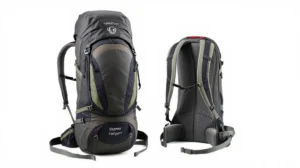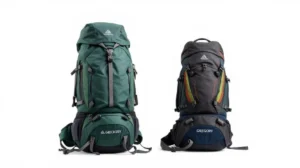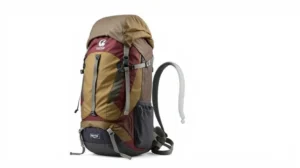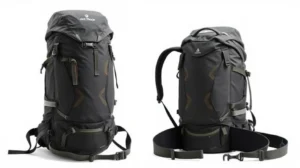Choosing the right hiking pack is essential for a successful hike, whether you’re embarking on a quick day trip or a multi-day trek. The right backpack will provide enough storage for your essentials, offer comfort, and have features tailored to your hiking needs. With a variety of hiking packs available, selecting the best one can seem daunting, but understanding key factors such as capacity, features, and fit will help you make the right choice. hiking pack one of the most important hiking gear for hikers.
Here’s everything you need to know about hiking packs, from choosing the right size to understanding essential features and top recommendations for 2024.
5 Top Hiking Packs for 2024
With so many options on the market, finding the perfect hiking pack can be a challenge. Here are some of the top hiking packs for men and women in 2024, known for their durability, comfort, and functionality.
1. Osprey Talon 22 (Men) / Tempest 20 (Women)

The Osprey Talon and Tempest packs are lightweight and versatile, making them perfect for day hikes or ultralight trips. They feature a comfortable back panel, hydration compatibility, and a variety of pockets for easy access to essentials.
Pros:
- Lightweight and comfortable
- Excellent ventilation
- Hydration compatible
Best For: Day hikes and ultralight trips.
2. Deuter Aircontact Lite 50+10 (Men) / 45+10 SL (Women)

The Deuter Aircontact Lite series is ideal for multi-day hikes, offering a balance of comfort, support, and lightweight design. These packs feature an adjustable torso, a breathable back system, and plenty of storage for overnight gear.
Pros:
- Adjustable fit
- Comfortable suspension system
- Large capacity with a relatively low weight
Best For: Weekend hikes and multi-day backpacking trips.
3. Gregory Baltoro 65 (Men) / Deva 60 (Women)

The Gregory Baltoro and Deva packs are known for their excellent support and comfortable suspension system, making them a top choice for long hikes with heavy loads. These packs are designed to carry gear efficiently while providing maximum comfort.
Pros:
- Durable and supportive
- Great for carrying heavy loads
- Excellent organizational features
Best For: Multi-day treks and long-distance backpacking.
4. REI Co-op Flash 55 (Unisex)

The REI Co-op Flash 55 is a lightweight, minimalist backpack that offers plenty of storage without unnecessary bulk. It’s perfect for hikers looking to reduce pack weight while still having room for essential gear.
Pros:
- Lightweight
- Versatile and customizable
- Affordable
Best For: Ultralight backpackers and minimalist hikers.
5. Arc’teryx Bora AR 63 (Men) / Bora AR 61 (Women)

The Arc’teryx Bora AR series is known for its rugged design and innovative RotoGlide hip belt, which moves with your body for increased comfort. These packs are built to handle tough conditions and heavy loads, making them ideal for serious backpackers.
Pros:
- Durable and weather-resistant
- Innovative hip belt for comfort
- Built for heavy loads and tough terrain
Best For: Long-distance hikes, rugged terrain, and extended trips.
2. Types of Hiking Packs
Hiking packs come in different styles and sizes, each designed for specific hiking durations and conditions. Here’s a breakdown of the most common types:
A. Daypacks
Daypacks are designed for short hikes and usually have a capacity of 15 to 30 liters. They’re perfect for carrying the essentials like water, snacks, a jacket, and a small first aid kit. Daypacks are lightweight and often feature hydration bladder compatibility, making them ideal for quick trips.
Best For: Day hikes, short trips, and ultralight hikers.
B. Weekend Packs
Weekend packs are designed for overnight trips and can carry between 30 to 50 liters of gear. These packs offer enough space for extra clothing, food, and camping gear, while still being light and manageable. Many weekend packs feature additional compartments and attachment points for items like sleeping bags and trekking poles.
Best For: Overnight trips, weekend hikes, or lightweight backpacking.
C. Multi-Day/Backpacking Packs
Backpacking packs typically range from 50 to 70 liters in capacity and are designed for multi-day hikes or long-distance treks. They have more storage space for larger items like tents, sleeping bags, and cooking gear. These packs are built to distribute weight evenly, with padded shoulder straps, hip belts, and adjustable suspension systems to ensure comfort during extended hikes.
Best For: Multi-day hikes, backpacking, and long-distance trekking.
D. Expedition Packs
Expedition packs are the largest hiking packs, with a capacity of 70 liters or more. They are designed for extended trips that last over a week or for carrying heavy loads in rugged conditions. These packs are often highly durable, with reinforced frames and extra features for gear attachment.
Best For: Extended treks, winter hiking, and expeditions with heavy gear.
3. Key Features to Look for in a Hiking Pack
When selecting a hiking pack, there are several important features to consider that will affect comfort, durability, and functionality. Here are the key factors to keep in mind:
A. Capacity
The size of your hiking pack depends on the duration and type of hike you’re planning. Here’s a rough guide to help you choose the right capacity:
- 15–30 liters: Day hikes and ultralight trips
- 30–50 liters: Overnight trips and weekend hikes
- 50–70 liters: Multi-day hikes and backpacking trips
- 70+ liters: Extended expeditions and heavy gear loads
B. Fit
A good fit is crucial to prevent discomfort and injury. Look for packs with adjustable torso lengths and waist belts to ensure the load is properly distributed. A well-fitting pack will place most of the weight on your hips rather than your shoulders, which prevents strain during long hikes.
Tip: When trying on packs, load them with weight to simulate real hiking conditions, and adjust the straps to find the perfect fit.
C. Frame Type
Hiking packs come with different frame options:
- Internal Frame: Most hiking packs feature an internal frame that helps stabilize the load close to your body. This frame design is ideal for balance on uneven terrain.
- External Frame: External frame packs are less common today but can be useful for carrying heavy loads or bulky gear like tents. They offer more ventilation but may feel less stable on rough trails.
- Frameless: Frameless packs are lightweight and ideal for ultralight hikers. However, they lack the support of framed packs, making them less suitable for heavy loads.
D. Ventilation
Proper ventilation helps keep your back cool and dry during strenuous hikes. Many hiking packs feature a mesh back panel or a suspended frame to allow airflow between your back and the pack.
Best For: Hikers in hot climates or those prone to sweating.
E. Hydration Compatibility
Many modern hiking packs come with hydration bladder compatibility, featuring an internal sleeve to hold the bladder and a port for the drinking tube. This is a convenient feature for staying hydrated without stopping to take out a water bottle.
F. Pockets and Compartments
Organization is key when hiking, and multiple pockets and compartments can help keep your gear easily accessible. Look for packs with side pockets for water bottles, front mesh pockets for quick-grab items, and hip belt pockets for snacks or small gear. A sleeping bag compartment is also a useful feature in larger packs.
G. Weight
The weight of the pack itself should also be considered. Lightweight packs are great for day hikes or minimalist trips, while heavier packs are often more durable and offer better support for long distances.
4. Caring for Your Hiking Pack
To ensure your hiking pack lasts for years, proper care is essential. After each trip, clean the pack by brushing off dirt and debris, and if necessary, wipe it down with a damp cloth. Air dry the pack before storing it to prevent mold and mildew. Store your pack in a cool, dry place, and avoid overloading it beyond its recommended capacity to prevent damage.
Final Thoughts
Choosing the right hiking pack is all about finding the perfect balance between comfort, capacity, and features. Whether you’re heading out for a day hike or embarking on a multi-day trek, having a reliable hiking pack will make your adventure more enjoyable. Be sure to prioritize fit, organization, and the right capacity for your needs, and you’ll be well-equipped for any hiking challenge.


